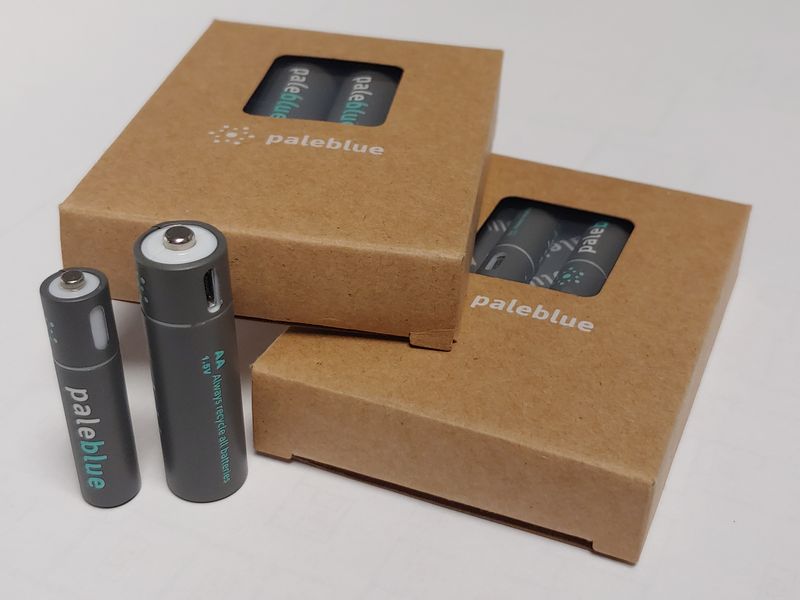
REVIEW – In America alone, 10 million batteries are thrown away every day. One pack of Pale Blue USB rechargeable lithium batteries can replace up to 4,000 alkalines. Making the switch can save you money and keep toxic disposable batteries out of landfills. But how do they perform? Read on to see what I think!
What is it?
The Pale Blue USB rechargeable lithium batteries are designed with state of the art power storage technology and are designed to be self sufficient so that they can be charged by virtually any USB power source. The batteries come in AA and AAA sizes.
What’s in the box?
- 4 Batteries
- Storage box
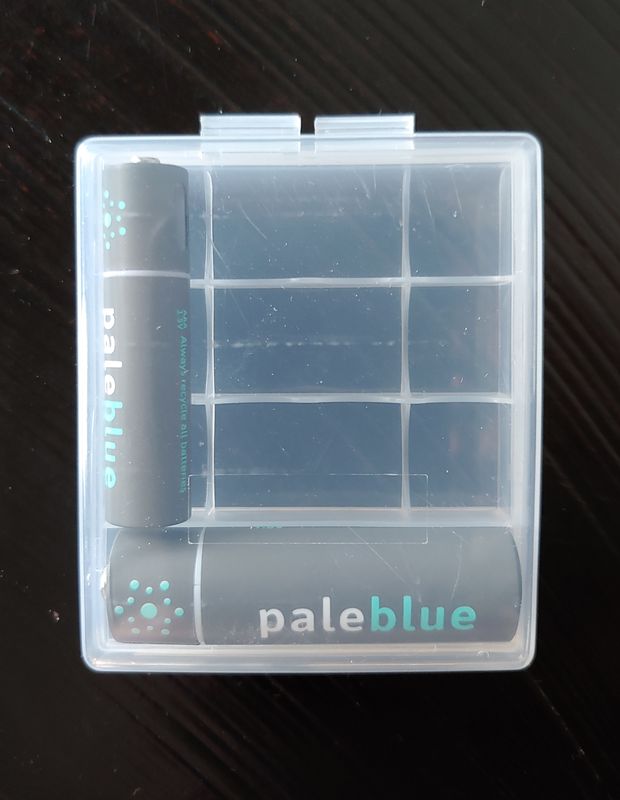
- charge cable
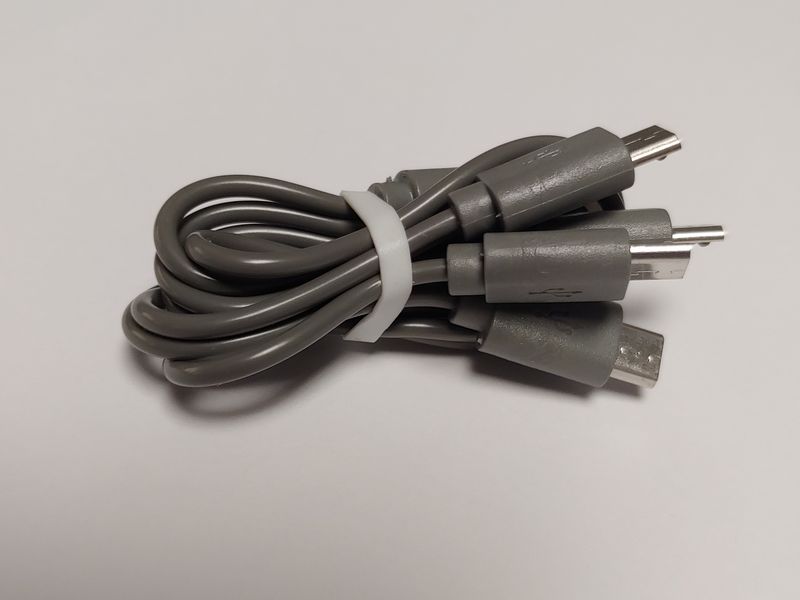
Hardware specs
| AA | AAA | |
| Chemistry | Lithium polymer (LiPo) | Lithium polymer (LiPo) |
| Power [W-h] | 2.25 Watt Hours | 0.675 Watt Hours |
| Voltage | 1.5v | 1.5v |
| Capacity [mAh] | 1560 mAh | 450 mAh |
| Charge Time | Under 2 Hours | Under 1 Hour |
| Cycle Rating | 1000+ Cycles | 1000+ Cycles |
| Charging Cable | 1 USB – 4 Micro USB | 1 USB – 4 Micro USB |
| Charge State Indicator | RGB LED | RGB LED |
Design and features
The original design of the AA battery is over 100 years old. Because of its long and reliable use, this size battery accounts for over 60% of battery sales in the US. The AAA is used less often and accounts for 24% of sales in the US. Since sales should roughly correspond with use, the AA and AAA Pale Blue batteries should be perfect for over 75% of the items that you use batteries for. Since the design of the batteries are standardized, the Pale Blue batteries are virtually guaranteed to work in your application.
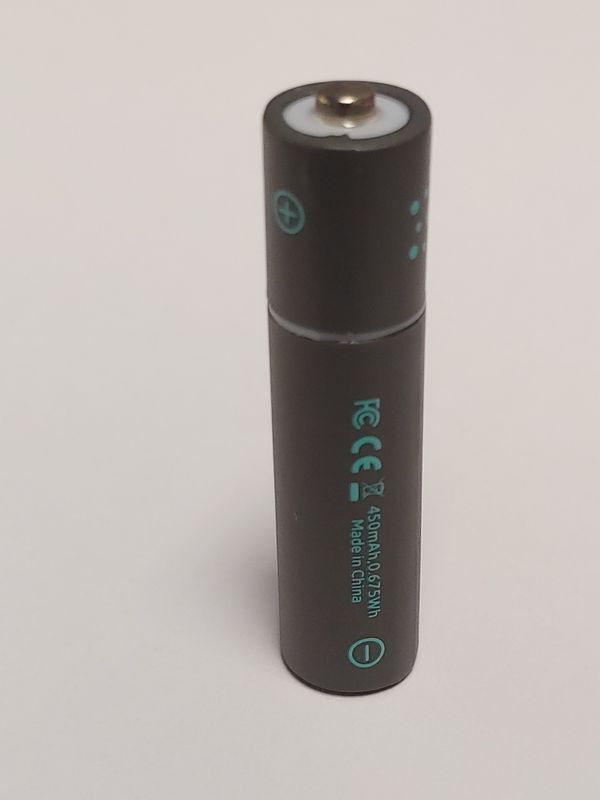
One thing that the international standards do not specify is the weight of the batteries. The Pale Blue is one of the lightest weight batteries available. The batteries pictured are a NiMH, Wegman’s alkaline, Duracell alkaline, and Pale Blue Li Po. The batteries weigh 31 grams, 23 grams, 23 grams, and 15 grams. The Pale Blue AAA weighs a paltry 8 grams.
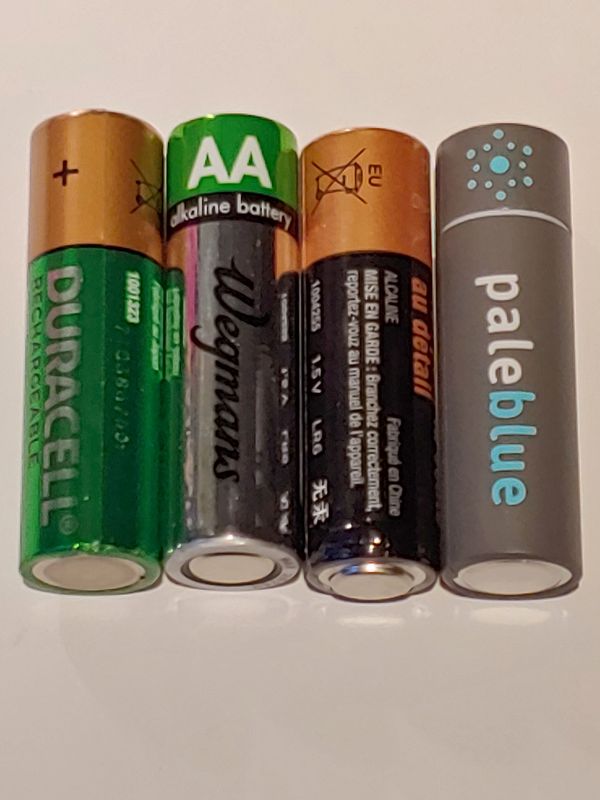
The design of the battery not only meets all of the standard requirements of the battery size and shape but also includes the charging circuit and voltage regulator inside. Other rechargeable batteries require a specialized charger but these batteries charge with a standard microUSB and this design makes them super portable. The batteries come with a USB cable that allows all four batteries to be charged simultaneously from one standard Type A USB port.
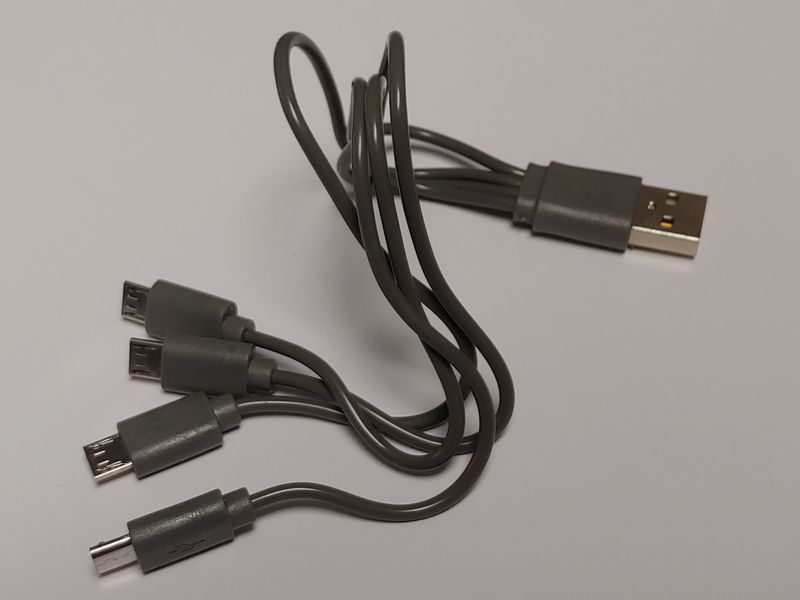
Even without the charging cable, these batteries can be charged in some malls and airports at cell phone charging stations. Even though USB-C is becoming more popular, thousands of products are still introduced with microUSB every year and this will still be a relevant power standard for years to come. Each battery will draw a maximum half an Ampere while charging so when charging four batteries simultaneously the charger should provide 2 Amp or more. The batteries will also charge with less current but will take longer to obtain a full charge. Note that the microUSB is for charging only and can not be used to power other devices like a battery pack.
The technology in these batteries is more advanced than the technology that has been used in previous generations of devices. Traditionally, rechargeable batteries have been powered by NiCd or NiMH power sources. These batteries will both lose significant power while in storage. NiMH batteries will also not provide as much power as NiCd or alkaline batteries, so high demand applications like radio controlled cars and drills may not be as fast or powerful. NiMH and NiCd also require about as many electrolytes as alkaline batteries so there is no room left in the battery for a charging circuit. This means that NiCd and NiMH will always have an external charging device. The LiPo chemistry that the Pale Blue batteries is based on has a very high discharge capacity, a very low resistance to charging and a very high energy density. This means that the Pale Blue batteries will stay charged for a longer time when not in use, can deliver a high amount of power while being used, and can be charged at a high rate. The high energy density means that the energy storage part of the battery can be smaller for the same capacity of energy typically stored in an alkaline battery and that there is still room for necessary circuitry and a charging port. In fact, LiPo can store approximately 350% more energy than a typical NiCd or NiMH battery.
The high energy density of LiPo does require that manufacturers pay close attention to the safe design of charge and discharge circuits. The misunderstanding and misapplication of LiPo caused thousands of hoverboards to be recalled at the end of 2017. The Pale Blue batteries have been designed to ensure that they operate safely. The batteries are certified to IEC 62133:2012, Secondary cells and batteries containing alkaline or other non-acid electrolytes – Safety requirements for portable sealed secondary cells, and for batteries made from them. The batteries have been certified to meet other safety requirements as well. The only requirement that they not be charged or used at extreme temperatures (outside of 0°C to 50°C range).
The batteries are very easy to use. The tops of the batteries rotate so that the microUSB is protected from dirt and dust. A slight twist of the top opens and closes the top.
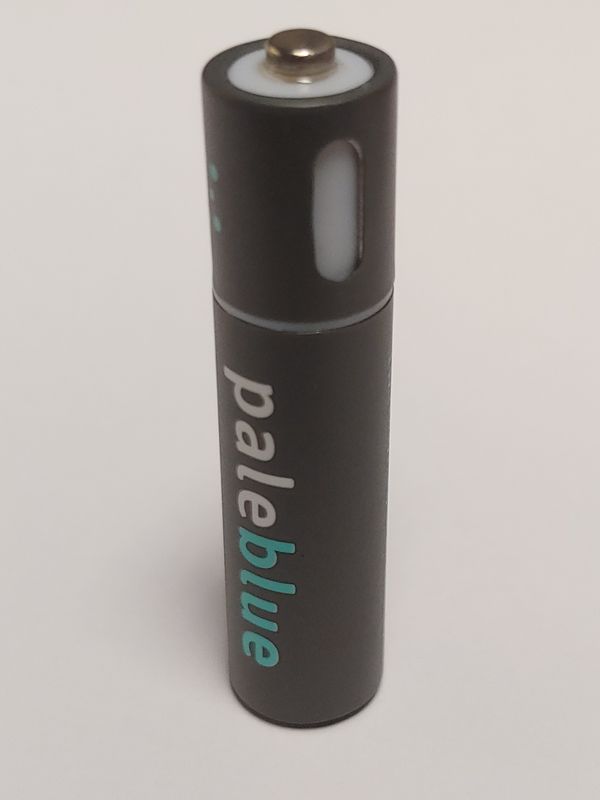
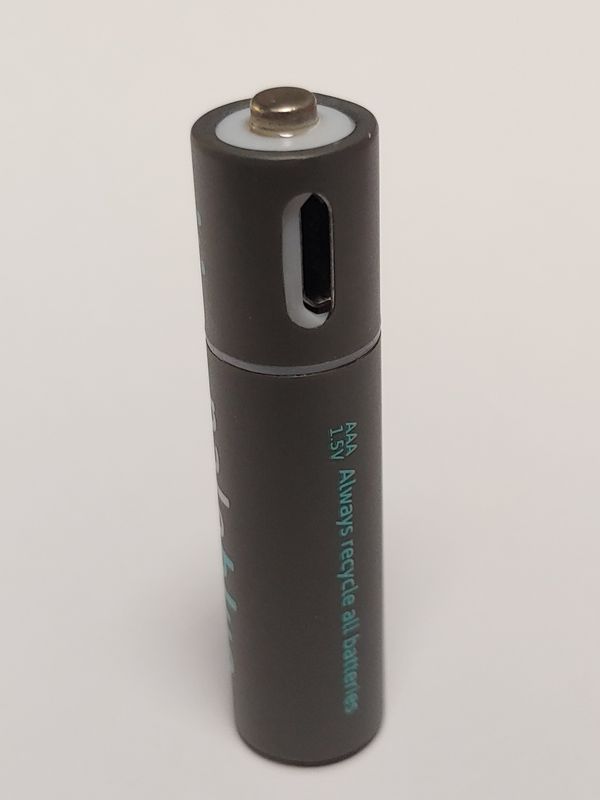
a red LED indicates that the battery is charging and a green LED indicates that charging is complete.
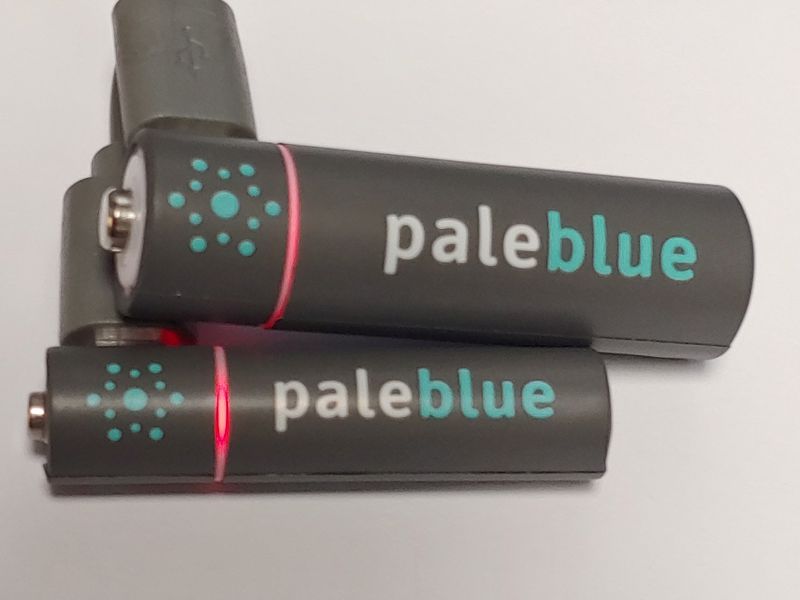
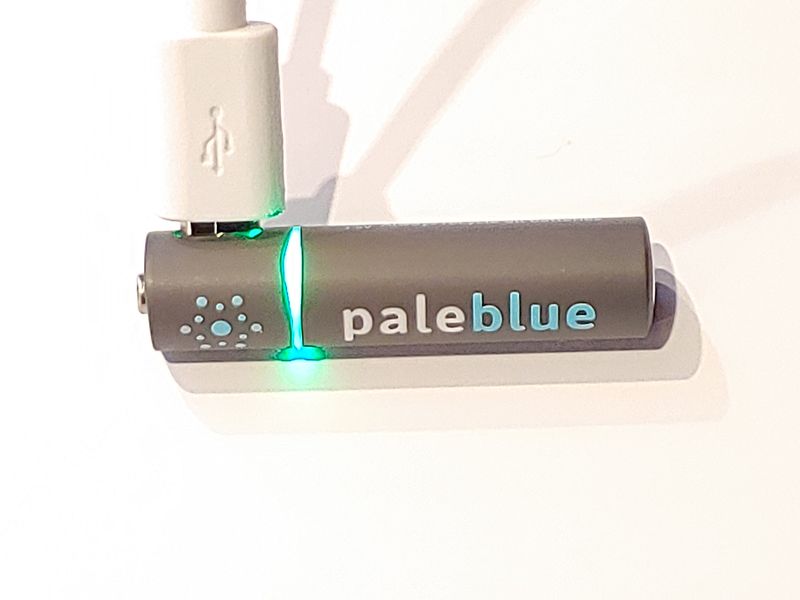
If it is technically possible, it would be great for the LED to blink a certain number of times at the start of charging to indicate the remaining battery capacity.
When the batteries are not being used they may be stored in the provided plastic container. The container is designed to hold 4 AA or 4 AAA and 1 AA. The picture above shows the way that each size battery fits into the case.
Performance
The performance of the batteries is indicated by the manufacturer to be superior to NiMH and comparable to alkaline. The rate of discharge is related to the powered circuit and the applied voltage. There are various curves that can be used to compare battery capacity and performance. Typically the chemistry of the electrolyte is determining the discharge properties. The Pale Blue battery discharge properties are electronically controlled to maximize the performance over time.
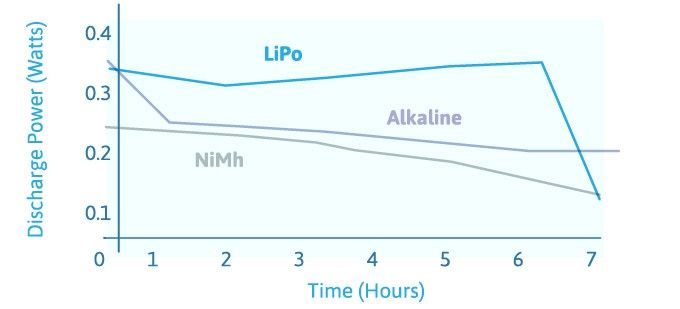
The Pale Blue also has an advantage that they are charged by a voltage regulating charging circuit. This means that charge time takes only a couple of hours and not the typical eight hours or more to charge a completely dead battery. The Pale Blue also has a circuit that protects the batteries from deep discharge – a condition in which the battery loses a significant portion of its charge holding capacity.
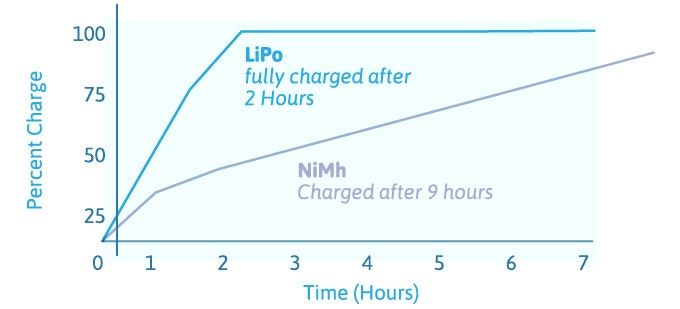
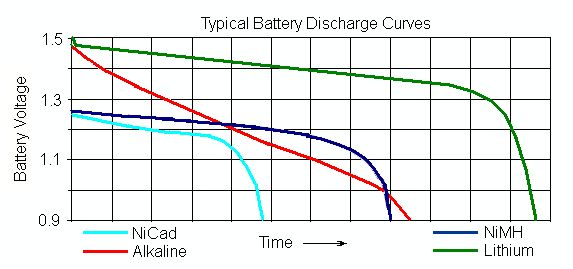
What I like
- High voltage output
- Easy to charge
- fast charging
What I’d change
- Battery Capacity indication
Final thoughts
The batteries are sold in packs of four and each battery can nominally be recharged 1000 times. So a $30 pack of 4 batteries can save $1,130 of 29 cent AA batteries and 96 kg (211 lb) of battery waste. These batteries will also save tons of carbon released as part of the battery manufacturing process. So rechargeable batteries are both economically and environmentally a better choice than disposable batteries. LiPo batteries are also an environmentally better option than NiCd. I’m happy that I can help curb waste by using these in my home and I suggest that you do the same!
Price: $29.99 for 4 AA, $24.99 for 4 AAA.
Where to buy: Pale Blue Earth
Source: The sample of this product was provided by Pale Blue Earth.



Gadgeteer Comment Policy - Please read before commenting
I know you mention it – but be realistic. We should be demanding USB-C in everything. It’s the universal charging standard we have been waiting for. I will not buy any USB product that is not USB-C.
Personally, I have many more micro USB cables than type-c cables. I agree with you, that over time, type-c will become more prevalent. There may be other considerations, however. Look at this image of type-c on the left and micro-usb on the right. you can clearly see that type c occupies more space. This may be a very important consideration in the AAA battery. And since there is a desire to have both batteries charge with the same cable the size of the connector may have constrained the design.
Let us know if you stumble across a USB-C AA/AAA rechargeable battery!
I note that the capacity of this expensive lithium ion AAA battery is 450mah. My regular Panasonic Eneloop AAA nickle metal hydrate rechargeable batteries have a capacity of 750mah and have no problem operating past 50 degrees centigrade. There is a version of the Eneloop AAA that is 900mah. Is it possible that this incredibly expensive lithium ion AAA is an ingenious solution to a non-existent problem?
And the voltage comparison? Critical in some applications.
Can you charge via USB and draw battery power at the same time? It would provide basic UPS capability to smaller devices.
The Typical Battery Voltage Discharge Curve graph above lists results for NiCad, Alkaline, NiMH, and Lithium but NOT for LiPo, which is the topic of this review. What is the Battery Voltage Discharge Curve for this LiPo battery?
My guess is it would be close to the Lithium curve because it is a Lithium polymer battery.
Assuming a constant current, you could integrate the discharge power to obtain a curve showing the remaining voltage, however the x scale of this curve depends on the current draw, and this wasn’t published for the composite curve above
Great review, there is one thing I would have liked to have seen discussed, that is the storage life, and usages in low discharge devices like a TV remote, where a battery will generally last a year. I am sold on at least a trial purchase, and will conduct my own tests on this.
Steve,
These batteries have an internal circuit that draws power so these batteries are better for devices that use batteries quickly versus batteries that are used very little over a long time. These are better for flashlights and portable fans than for remote controls. Also, others have reported issues with XBOX controllers. These batteries are probably better for devices that don’t have their own voltage controller since the output on these may confuse the devices that expect a typical battery.
Could this be my problem. I’ve just started to use Pale Blue batteries and yesterday I came up with the first thing that didn’t power up. It was my Fluke Clamp meter. In the same storage box was my Infrared thermometer and that one also didn’t work. Everything else I’ve tried works great. So could it be their voltage controllers that prevent them from working.
I need new batteries in my Peugeot salt and pepper grinders. The Tenergy ones I’ve been using for years are getting weak.
All the other rechargeable AAA batteries I have seen are rated at 1.2 volts. Are these really 1.5 volts? How do they do it?
Questions:
1.) How long can the Pale Blue Batteries hold a charge, (not in use) but in storage?
2.) Can the Pale Blue Batteries be charged through a regular AC/DC 115/120 wall outlet?
The pale blue batteries use a built in regulator (presumably buck) to convert the 3.7V of the Li ion cell down to 1.5v, so the voltage discharge-curve of a lithium cell is irrelevant here. You will get a flat 1.5v across the entire discharge range. The 9v pale blue batteries use a boost regulator instead, with the same result. The only possible issue for some sensitive equipment will be the noise of the switching regulator that is no doubt present at the output.